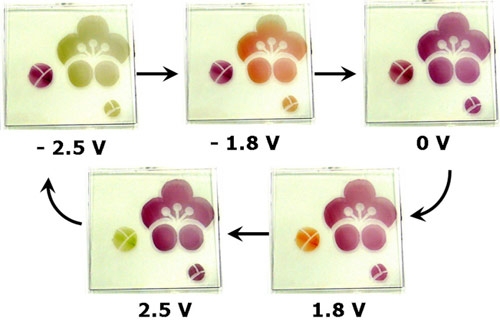Success in Development of Multi-Color Electronic Paper
National Institute for Materials Science
The National Institute for Materials Science and the Japan Science and Technology Agency developed a multi-color electrochromic display device using an organic/metal hybrid polymer which exhibits electrochromic properties.
Abstract
- The National Institute for Materials Science (hereinafter, NIMS; President: Prof. Teruo Kishi) and the Japan Science and Technology Agency (JST; President: Koichi Kitazawa) developed a multi-color electrochromic display device using an organic/metal hybrid polymer which exhibits electrochromic properties. This result was achieved by a team headed by MANA Young Scientist Masayoshi Higuchi of the NIMS International Center for Materials Nanoarchitectonics (MANA; Director General: Masakazu Aono).
- Electronic paper has attracted attention as a next-generation display device following liquid crystal, plasma, and organic EL displays. Because display by electronic paper is maintained even when the power is cut off, unlike that in conventional devices, high expectations are placed on this type of material as a resource saving/energy saving type of display, and in the future, as a substitute for the paper medium in newspapers and other printed matter. At present, however, color display in electronic paper is a technical challenge. Although the electrochromic method has been mentioned as a drive system which is suitable for color display, development has been delayed due to the low durability of the material, difficulties in realizing solid-state devices, and other problems.
- In the device developed by NIMS and JST, an electrochromic display device was realized using an organic/metal hybrid polymer that exhibits electrochromic properties. This polymer was developed by NIMS.
- The polymer used is an organic/metal hybrid polymer in which metallic ions and organic molecules assume a form resembling a string of beads. Previous work has shown that this novel polymer, unlike conventional electrochromic materials, has high-repeatability drive stability. By applying ingenuity to the species of metallic ion introduced in the hybrid polymer and the device structure, the researchers succeeded in realizing a multi-color electrochromic device which is capable of expressing five types of display patterns. The device is thin, having a thickness of only 2mm, and colors can be changed simply by varying the voltage in the range of -2.5V to +2.5V. As a result of this invention, great progress is expected in the future in research aiming at practical application of flexible colored electronic paper which is as thin as ordinary paper and large-scale devices such as posters, thermotropic glass, and similar applications.
- This result was achieved as part of the research topic “Single Layer Multi-Color Electrochromic Materials” (Research Representative: Masayoshi Higuchi) of the “Search for Nanomanufacturing Technology and Its Development” region (Research Supervisor: Naoki Yokoyama), as individual type research under JST’s Precursory Research for Embryonic Science and Technology (PRESTO) program, and is scheduled to be announced at the Environment and Energy Materials Research Exhibition to be held March 29-30 at the Tokyo Big Sight International Exhibition Center.

Fig.: Multi-color changes in the electrochromic display device. The device is capable of expressing 5 types of display patterns simply by varying the voltage in the range of -2.5V to +2.5V.